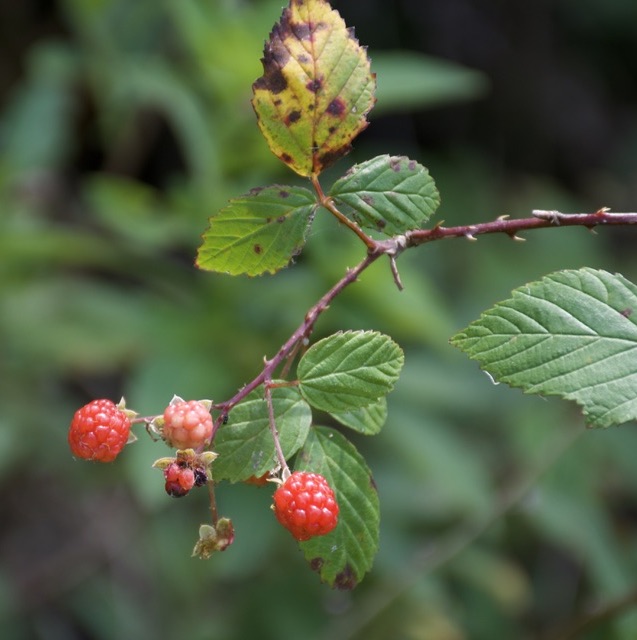
Wild Blackberries will ripen soon. Photo by Green Deane
Now is the time to go looking for blackberries. They are just coming into season with a few tart black ones and many pink to red berries aripening. Even when very sweet wild blackberries have a bitter note or aftertaste. That comes from the center, which stays with the blackberry when picked. That also gives it more shelf-life. Raspberry, in the same genus, leave the core behind when picked which is why they are sweeter and go bad quicker. If you have enough large blackberry shoots they can be peeled, boiled and eaten. The roots can produce a bit of sugar. Beside the fruit the most common use is the leaves for tea. It’s tasty and medicinal. Having foraged for them from Maine to Florida I think the farther north one goes the better the berry gets. To read more about the blackberry click here, and here.
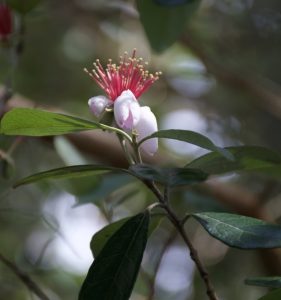
Pineapple Guava blossoms are always attractive. Photo by Green Deane
Perhaps no ornamental was championed as much as the Pineapple Guava. However the perfect shrub for many places never really caught on. There could be several reasons. It probably didn’t help that a close relative, the Strawberry Guava, is a severe invasive species in some locations. The shrub also does not get showy. You have to hunt for the extroverted blossoms. While the entire blossom is edible most people only eat the petals. Five or six months from now they will be dark green fruit that stay green as they ripen. They just get softer. The shrub is easy to identify when in blossom. To read more about both guavas, go here.
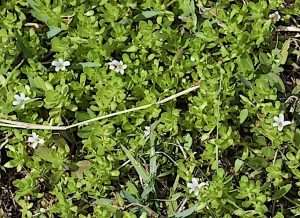
Bacopa — Water Hyssop — blossoms all year but it likes the spring. Photo by Green Deane
We have six Bacopas locally. However you are interested in only two. Four are rare and the other two common in most places. One is Lemon Bacopa the other Water Hyssop. You can find them in the same wet location but usually it Water Hyssop, which is the one most want because it’s linked by good research to facilitating memory. Lemon Bacopa tastes like lime to me and makes a nice, crisp tea. Whether it is good for you or not is a bit of a debate. It’s not as well known or researched as its genusmate, botanically Bacopa monnieri, which is extremely bitter. To read about them go here.

Foraging classes are held rain or shine, heat or cold. Photo by Nermina Krenata
Foraging Classes: Has your food supply been interrupted? It’s a good time to learn foraging for wild food. I know folks are allowed in Mead Garden in Winter Park and Pinellas County is allowing groups of ten or less to gather. So I will have a class at Mead Garden this Saturday and a class at Eagle Lake Park in Largo on Sunday. These classes will go on unless some authority changes its mind.
Saturday, May 2nd, Mead Garden: 1500 S. Denning Dr., Winter Park, FL 32789. Meet at the parking lot. 9 a.m. to noon.
Sunday, May 3rd, Eagle Park Lake, 1800 Keene Road, Largo, FL 33771. Meet at the pavilion near the dog park. 9 a.m to noon.
Saturday, May 9th, Blanchard Park, 10501 Jay Blanchard Trail, Orlando, FL 32817. 9 a.m. to noon, meet at the tennis courts next to YMCA building.
Sunday, May 10th, Bayshore Live Oak Park, Bayshore Drive. Port Charlotte. 9 a.m to noon, meet at the park across from Ganyard Street.
Saturday, May 16th, Spruce Creek Park, 6250 Ridgewood Ave. Port Orange FL, meet at the pavilion. 9 a.m. to noon.
Sunday, May 17th, Red Bug Slough Preserve, 5200 Beneva Road, Sarasota, FL, 34233. 9 a.m. to noon.
For more information, to sign up for a class, or to pre pay, go here.
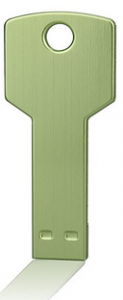
Green Deane’s videos on USB.
There are changes coming to my video offerings. My nine-DVD set of 135 videos has been selling for seven years. The format, however, is becoming passe. So starting soon those 135 videos plus 15 more will be available on a 32-gig USB drive. Both the 150-video USB and the 135-video DVD set are now $99. The DVDs will be sold until they run out then will be exclusively replaced by the USB. This is a change I’ve been trying to make for several years (with thanks to Mike Smith.) So if you have been wanting the 135-video DVD set order it now as the price is reduced and the supply limited.The USB is actually available now but getting the order page on WordPress changed is proving to be a challenge (as is everything on WordPress. I had a two rewrite this newsletter completely twice.) These are the same video I have on You Tube. If you can’t wait and want them now you can use the green donation link at the bottom. “Donate” $99 and specify either the USB drive or the DVD set. Include a mailing address. You can also send information about your order to GreenDeane@gmail.com. The link to the order page is here but I don’t know when it will reflect these changes.
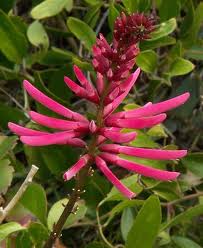 Also blossoming this time of year is the Eastern Coral Bean, sometimes called the Cherokee Bean. What is odd about this plant is the edible flowers produce toxic beans. So we do not eat the red and black beans. A few of the red blossoms are edible raw — with precautions — but they are usually boiled then mixed with other foods notably scrambled eggs. When you cook the blossoms they turn light green. The distinctive shape of the leaves makes the shrub easy to identify. Young leaves are edible cooked but are marginal fare. Like the Pawpaws above they prefer dry, sunny places. A few raw red blossoms seem okay but if eaten in larger amounts they can be mind altering and approaching dangerous. Boiled they are fine. (Juice from the shrub’s stems, by the way, has been used to treat scorpion stings.) You can read more about the Eastern Coral Bean here.
Also blossoming this time of year is the Eastern Coral Bean, sometimes called the Cherokee Bean. What is odd about this plant is the edible flowers produce toxic beans. So we do not eat the red and black beans. A few of the red blossoms are edible raw — with precautions — but they are usually boiled then mixed with other foods notably scrambled eggs. When you cook the blossoms they turn light green. The distinctive shape of the leaves makes the shrub easy to identify. Young leaves are edible cooked but are marginal fare. Like the Pawpaws above they prefer dry, sunny places. A few raw red blossoms seem okay but if eaten in larger amounts they can be mind altering and approaching dangerous. Boiled they are fine. (Juice from the shrub’s stems, by the way, has been used to treat scorpion stings.) You can read more about the Eastern Coral Bean here.
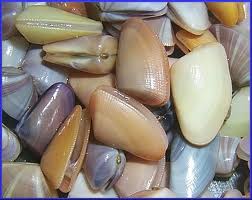
Coquina are tasty but quite small.
Sometime instead finding answers they find you. As you know there are several articles on the EatTheWeeds website that are about edibles covered by the subtitle: And other things, too. That subtitle was intentionally added when the site went up some 15 years ago. There are a lot of things in the world to eat. Before Andrew Zimmern was traipsing around the globe for the Travel Channel eating untraditional food EatTheWeeds was writing about them. As one might expect that has caused a good amount of disagreeing mail. Many people keep as pets creatures that other people eat. Thus far, however, no one has complained about Coquina, a coastal clam that’s about the size of your fingernail. The tiny clams make an absolutely delicious green broth that I like to add — I know it’s sacrilege — to instant potatoes with butter. One of the down sides is the clams are so small getting the meat out of the shell is microscopic work. That is so frustrating as most of it is tossed away. However in Australia they figured out a commercial way of separating meat and shell. How that was done was something of a mystery until a post on the Green Deane Forum provided an answer. The cooked shells are vigorously stired. After that it is a matter of straining the smaller meat from the larger shells. I’ve got to try that. You can read about Coquina here, and the crunchy Mole Crabs, here. A video on both of them is here.

Green Deane Forum
Want to identify a plant? Perhaps you’re looking for a foraging reference? You might have a UFO, an Unidentified Flowering Object, you want identified. On the Green Deane Forum we — including Green Deane and others from around the world — chat about foraging all year. And it’s not just about warm-weather plants or just North American flora. Many nations share common weeds so there’s a lot to talk. There’s also more than weeds. The reference section has information for foraging around the world. There are also articles on food preservation, and forgotten skills from making bows to fermenting food.
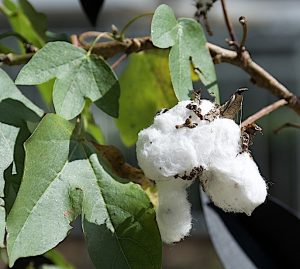
Cotton is not for consumption. Photo by Green Deane
Did you know cotton is toxic? Well, not the entire plant per se but cottonseed oil. Setting aside the molecular make up of its fat content for the moment the unrefined oil has Gossypol. That’s a naturally occurring toxin which protects the plant from insect predation. In fact, unrefined cottonseed oil was used as a pesticide. It can also be used to make candles and fuel oil lamps. In humans unrefined cottonseed oil has been linked to liver damage and infertility. Said another way if you are going to consume cottonseed oil you do not want “virgin” cottonseed oil. You want something more refined. Cottonseed oil is 52% polyunsaturated fats, 26% saturated fats and 18% monounsaturated fats..
This is weekly newsletter 403, If you want to subscribe to this free newsletter you can find the sign-up form in the menu at the top of the page.
To donate to the Green Deane Newsletter click here.


Just FYI. In TN & SC the blackberries are just now getting full white blooms so I can note their whereabouts. 4th of July is the mid-ripe date. Some start ripening the week before and some still ripening the week after. 🙂
Have purchased your video bundle in the past. Love it. Continually go back to it for reference. Is there going to be any discount for your followers that have already purchased the DVD set? Thank you for sharing with us your work.
Mark F.
Do you know the local location of any Guava trees ?
They grew wild in Palm Beach county especially along the Palm Beach Canal west towards Wellington. We harvested them frequently and made Guava Jelly. A lot of work to peal, pit, and cook down. A lot of sugar also. But great jelly.